Apple iPad mini with Retina Display: Reviewed
by Anand Lal Shimpi on November 16, 2013 8:00 AM EST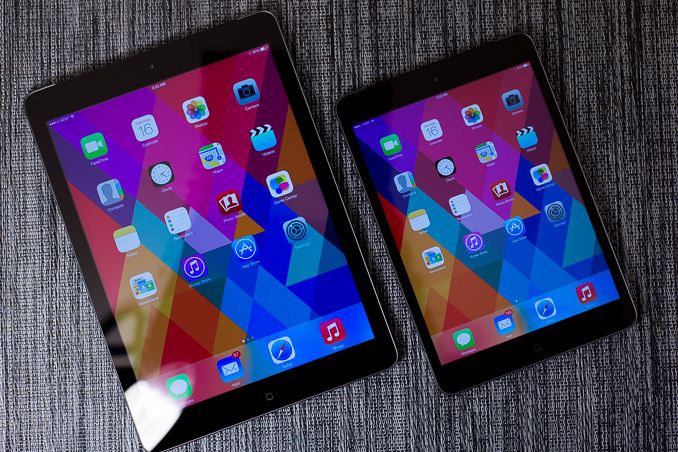
I suppose there’s only one way to start this review, and that’s by looking back at last year’s iPad mini review. In that review I had a section dedicated to the possibility of an iPad mini with Retina Display. The low resolution display and slow SoC were my only two real complaints about the first iPad mini. I listed a bunch of options that Apple had for the mini going forward:
“Apple has preferred outright quadrupling of pixel count (2x in each dimension) to create a Retina Display. With the mini's display using a 1024 x 768 resolution, this option would give it a 7.85-inch 2048 x 1536 panel. That would be the same resolution as the iPad 3/4, but in a much smaller display giving it a pixel density of 326 PPI (vs ~263 for the iPad 3/4). Apple could do this, but it would then need to make all of the same changes it made in going to the iPad with Retina Display, primarily the introduction of a larger battery and much larger SoC. The bigger battery is needed to drive the more powerful backlight, and the X-series of SoCs is needed to actually render the UI and games at such a high resolution. Both of these things would increase the size and cost of the mini, which would make it distinctly un-mini.”
What I wrote last year was more or less what Apple decided to do this year, had I stopped there I wouldn’t have ended up with egg on my face. Naturally I didn’t. At the end of that page I concluded the following:
“None of these options is particularly enticing for Apple, especially given the low (for Apple), starting price for the iPad mini. If you're expecting next year's mini to have a Retina Display, I wouldn't hold your breath.”
And this is why I don’t like making predictions.
I hadn’t expected display power to go down as much as it did. I didn’t think battery density would improve as much as it did. And I definitely didn’t think Apple would integrate a large 4MB cache on its SoCs, thereby reducing the need for a super wide memory interface. The combination of those three things made giving the iPad mini a Retina Display possible, and that’s exactly what Apple did this year.
It’s called the iPad mini with Retina Display, and unlike the iPad Air, it looks a lot like its predecessor. You’d be hard pressed to notice the 4.1% increase in thickness (+0.3mm) or the 7.5% increase in weight (+23g). Even if you did, what those slight gains net you is more than worth the effort.

From top to bottom: iPad mini, iPad mini with Retina Display, iPad Air
The Retina mini now features a 44% larger battery (23.8Wh). That’s nearly the same battery capacity as the original iPad (25Wh), but in a chassis with only 1/3 of the volume. This is also the highest capacity battery we’ve ever seen in a tablet of this size. The negligible impact on weight and thickness is pretty impressive.
The battery enables the two killer features of the new mini: mainly Apple’s A7 SoC and of course, the 7.85-inch 2048 x 1536 Retina Display. Effectively addressing my chief issues with the original iPad mini, the new mini is substantially faster and comes with a significantly better display. Keep in mind the original mini debuted with an n-1 SoC (Apple’s A5 the year the A6 came out), which makes the move to the A7 this year even more substantial of an upgrade. While casual users would be hard pressed to tell the difference between an A6 and an A7, anyone who actively used last year's iPad mini will appreciate just how much quicker the new one is (particularly if you’ve upgraded to iOS 7). It’s awesome silicon enabling a much better experience.
The display itself needs no real explanation. The first generation iPad mini featured a 1024 x 768 display, which was passable but not ideal. I had no problems recommending that mini given how good the rest of the experience was, but it’s clear that it could’ve been better. Moving to a 2048 x 1536 panel not only gives the mini the right to use the term Retina Display, but the title of highest density display in Apple’s lineup as well.
The rest of the chassis looks otherwise identical to the original mini. Apple likes to keep its mobile designs around for at least two generations, and the mini is no exception. By no means is this a complaint however. I'm just as enamored with the high quality mini chassis as I was last year. I think Apple nailed the size of the smaller iPad the first time around; 7.85-inches isn't too narrow nor is it too wide.
The face of the tablet is marked by an asymmetric bezel, identical to the iPad Air. The sides are narrow, while the top/bottom are thicker in order to accommodate the physical home button and FaceTime HD camera. Just like before, Apple does a little bit of extra work in rejecting thumbs placed on either edge of the mini to make up for the lack of side bezel to hold.
The back is a solid piece of aluminum, available in either a light silver or space (dark) grey finish. Just like with the iPhone, the silver model gets a white treatment on the front with a lighter chamfer while space grey comes with a black trim and gunmetal chamfered edge. Models with a cellular modem feature a plastic RF window along the top edge of the tablet just like the bigger iPad.
Along the edges you’ll find power/lock up top, volume up/down and a rotation lock/mute toggle on the right side. If you have a cellular model you’ll also find a nano SIM tray along the right side of the mini.
The bottom edge is home to Apple’s Lightning connector, flanked on either side by speakers. The mini sounds pretty good although you do get better low frequency reproduction out of the larger iPad Air.
The iPad mini with Retina Display features the same 5MP iSight (rear facing) and 1.2MP FaceTime HD (front facing) cameras as the iPad Air. Complementing both is a dual-mic setup for background noise removal, once again identical to the iPad Air.
The mini is available in the exact same configurations as the iPad Air. It starts at $399 with 16GB of storage, and is available in 32/64/128GB options (+$100 for each increase in storage level). Cellular connectivity is also an option, once again at a $130 adder. Just like the iPad Air, the mini with Retina Display is only available in a single LTE SKU with support for 14 different bands and ships unlocked.
| iPad Specification Comparison | ||||||||
| Apple iPad Air | Apple iPad 2 | Apple iPad mini (Retina) | Apple iPad mini | |||||
| Dimensions | 240 x 170 x 7.5 mm | 241.2 x 185.7 x 8.8mm | 200 x 134.7 x 7.5mm | 200 x 134.7 x 7.2mm | ||||
| Display | 9.7-inch 2048 x 1536 IPS | 9.7-inch 1024 x 768 IPS | 7.9-inch 2048 x 1536 IPS | 7.9-inch 1024 x 768 IPS | ||||
| Weight | 469g (WiFi) | 601g (WiFi) | 331g (WiFi) | 308g (WiFi) | ||||
| Processor | Apple A7 (2 x Cyclone 1.4GHz, PowerVR G6430) | 1GHz Apple A5 (2 x Cortex A9, PowerVR SGX543MP2) |
Apple A7 (2 x Cyclone 1.3GHz, PowerVR G6430) |
1GHz Apple A5 (2 x Cortex A9, PowerVR SGX543MP2) | ||||
| Connectivity | WiFi , Optional 4G LTE | WiFi | WiFi , Optional 4G LTE | WiFi , Optional 4G LTE | ||||
| Memory | 1GB | 512MB | 1GB | 512MB | ||||
| Storage | 16GB—128GB | 16GB | 16GB—128GB | 16GB—64GB | ||||
| Battery | 32.4Wh | 25Wh | 23.8Wh | 16.5Wh | ||||
| Starting Price | $499 | $399 | $399 | $299 | ||||
The old mini still sticks around at $299, although like the iPad 2 that’s still on sale you’d be hard pressed to hear me recommend it. Perhaps if you really don’t mind the lower resolution display, far slower SoC and want to save a little money without abandoning iOS. For most folks the iPad mini with Retina Display is where it’s at. If you’re a heavy tablet user, the experience is really night and day. While the iPad Air’s form factor is what defined its experiential improvement, the iPad mini with Retina Display relies on the display and silicon to do the same.
Weight and Usability
So much of the experience of using a tablet is tied to the weight and distribution of said weight. The iPad Air is proof of just how true that is. Whereas the iPad Air straddled the line between comfortable one and two handed usage, the mini finds itself squarely in one handed territory. Picking up the mini after using the Air for a couple of weeks feels like I’m barely holding anything. The mini is by far the more comfortable of the two tablets to hold while lying down. Sitting upright I’m not sold on the weight loss being a huge benefit compared to the mini, but if I’m relaxing the mini is just so much nicer to hold.
| iPad Dimensions/Weight Comparison | ||||||||
| iPad | iPad 2 | iPad 3/4 | iPad Air | iPad mini (Retina) | iPad mini | |||
| Height | 243 mm | 241 mm | 241 mm | 240 mm | 200 mm | 200 mm | ||
| Width | 190 mm | 186 mm | 186 mm | 170 mm | 134.7 mm | 134.7 mm | ||
| Thickness | 13.4 mm | 8.8 mm | 9.4 mm | 7.5 mm | 7.5 mm | 7.2 mm | ||
| Weight | 680 g | 601 g | 650 g | 469 g | 331 g | 308 g | ||
The chassis is narrow enough where I can just barely get one hand around the entire thing and use it like a giant smartphone. If I hold the mini in both hands like a smartphone I can actually type away super quickly using my thumbs. The latter is a use case I found myself in pretty frequently as the mini is small enough that I’d be willing to carry it with me everywhere, particularly when in a case. While the iPad Air is too big to hold in portrait mode and comfortably type on with my thumbs, the mini is too small to hold in landscape mode and use like a regular keyboard. For typing out long emails like I would on a notebook, the iPad Air is the better option assuming I can get to a desk or can sit down. If I can’t have either of those things, the iPad mini is a better companion.
Apple sent an LTE model, which basically duplicated most of the functionality of my smartphone. With the LTE mini my smartphone stayed in my pocket more, although there are tons of combinations of small/large phone/tablet that you can enumerate for optimum computing these days. In many ways it’s like the discussion between small notebook + desktop vs. large notebook + docking station.
The mini’s smaller display does make reading some content a little more difficult compared to the big iPad. Reading, particularly given the new Retina Display, is pretty good on the mini. Small text is always easier to read when it’s on a larger display, but if you’re looking at content that’s properly formatted for a tablet you’ll be in good shape on the mini. I was asked to look into the comic reading experience on the mini and also came away pretty pleased. Text bubbles were definitely not as easy to read as on the iPad Air, but overall the experience was still good in most of what I read. Ultimately you don’t sacrifice a ton of functionality if you choose the mini instead of the Air. What you do lose, you definitely make up in portability. It’s really a question of where you’re going to use the tablet that’ll determine which one to go with.
Cases
Like the iPad Air, the iPad mini is light enough that using any sort of case adds a good amount of weight to the device (percentage wise). I found myself taking the mini out of its case to use, and just keeping it protected when on the go.
Since the mini hasn’t really changed in form factor, the two first-party cases are pretty similar to what we got last year (the covers work with both mini generations). Like its bigger brother, the mini is offered with an optional Smart Cover ($39) or Smart Case ($69) depending on how much protection you want.
Apple sampled me a black Smart Cover and a Product Red Smart Case for the iPad mini. I thought both looked great on the space grey mini. It’s worth pointing out that the red Smart Case is a less saturated color than the red Smart Cover I evaluated with the iPad Air.
The Smart Cover attaches to the left side of the mini with a magnetic hinge. If you’ve lined up the magnets properly, the attractive force is strong enough to support the weight of the mini if you pick it up by the cover (though I wouldn’t recommend doing so). Magnets in the edge of the cover furthest from the hinge signal sleep/wake on the tablet itself.
The Smart Case has the same sleep/wake functionality, but instead of attaching to the mini with magnets the tablet sits inside the case for protection on both sides of the tablet. The Smart Case is what I prefer to travel with, though it is far more difficult to get in/out of and obviously adds the most weight to the device.
Both covers feature the same three fold design and can double as a stand for the tablet. Since the previous mini used the same type of cover, the angle of the stand doesn’t change like it did with the Air.
The inside surface of each cover is lined in microfiber, while the outside is made of either soft-touch polyurethane (Smart Cover) or leather (Smart Case). Both do a good job of protecting the mini and neither showed excessive wear during my review period. I still have the 1st generation mini’s Smart Cover and that one appears to have held up well over the past year.


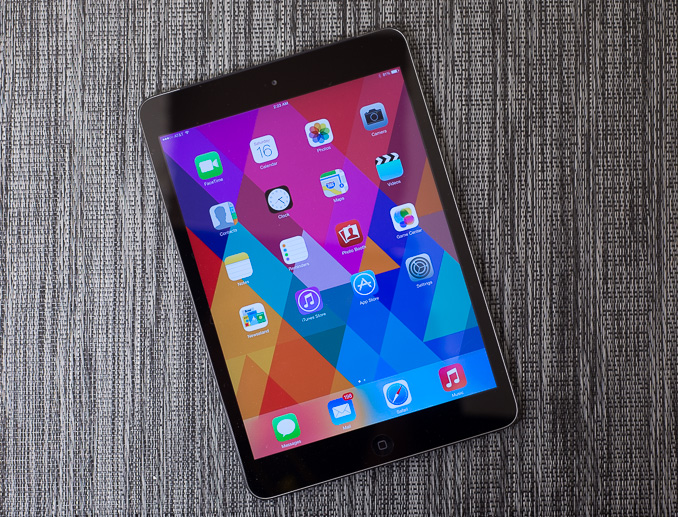
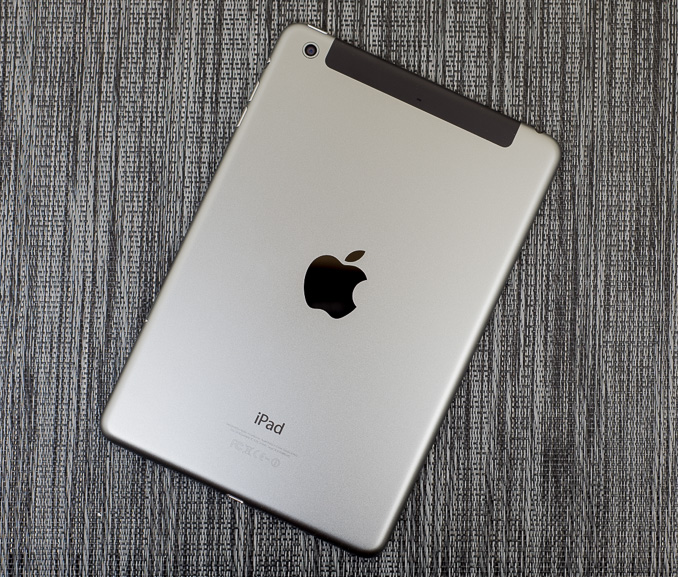
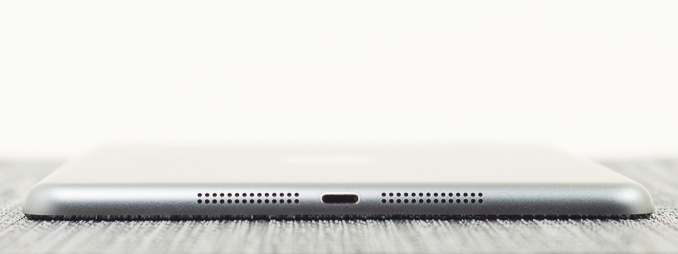






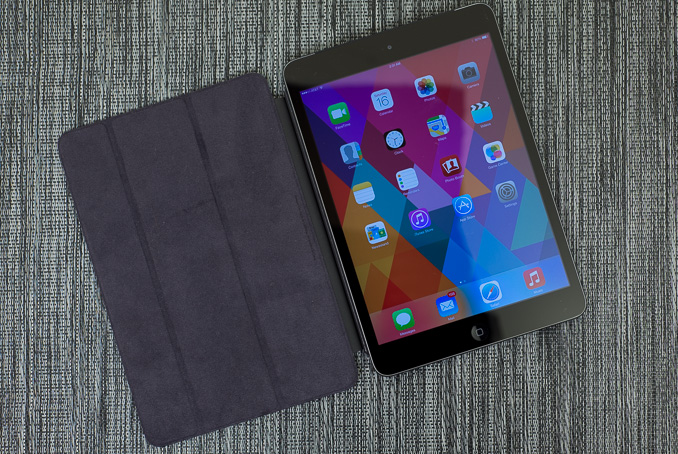
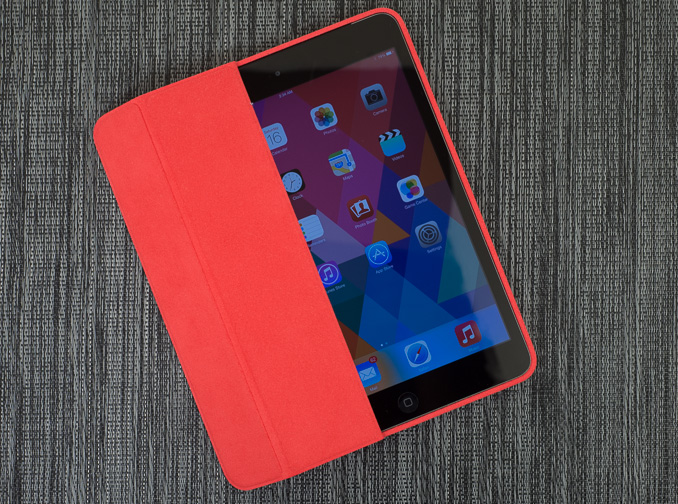









345 Comments
View All Comments
psyside1 - Sunday, November 17, 2013 - link
@Renasena ,No TouchID no thanks I'll wait till next year.
ROFL!!!!!
kwrzesien - Monday, November 18, 2013 - link
Do you want retina mini's or not? TouchID is constraining the 5s production, and retina displays are constraining the mini. Why risk it? And yes, there is next year...TouchID, laminated glass with correct color gamut (as they get production worked out on the panels and multiple manufacturers), A8 processor with 2GB RAM, and 802.11ac/other radio & cellular band improvements. And 32GB of base memory with $75 upgrades to 64 and 128, please!BreakingStrata - Saturday, November 16, 2013 - link
Seems like every time a review of an Apple product gets put up on this site there's always several people who are up in arms over a perceived positive bias towards Apple products. That's probably because the author of this article (and owner of this website) uses all Apple products. He also pretty much never reviews anything but Apple products now. That doesn't paint a very good picture does it? Someone who rarely reviews anything that isn't Apple but always finds the time to review a Apple products and primarily uses only Apple products clearly would not be in a position to give clear, unbiased reviews.This is very sad to me. I've been a regular reader for years. This site helped me fuel my passion for technology and I've learned so much from here. I used to have a tremendous amount of respect for this site and Anand but I can't anymore. I think people like myself read reviews because we want accurate and unbiased information. If we wanted biased information we would look at press releases or ask peoples personal opinions.
The only thing that keeps me coming here is the excellent reviews put out by the other authors here. I can still read their articles without a bad taste in my mouth. It all boils down to this one thing- actions speak louder than words.
ws3 - Saturday, November 16, 2013 - link
The bias is all yours.Anadtech reviews Apple products and gives them mostly positive reviews because they are mostly high quality, high performing products. That is all.
Whether or not you like iOS or the iOS App ecosystem is completely irrelevant. It's like me griping about a car review site that spends a lot of time reviewing two-seat sports cars when I'm interested in minivans. It's not bias on the part of the reviewer when he gives good reviews to a Ferrari.
Commodus - Sunday, November 17, 2013 - link
That's a slightly amusing remark given that he recently reviewed the Surface Pro 2 and liked it. I think you're confusing the nature of the product cycle with review preferences. Apple launched a flood of new gadgets recently, ergo they're going to get reviews shortly afterward.The issue isn't bias; Anand clearly qualifies his statements. Are the new iPads not faster overall than other mobile OS tablets on the market? Do they not have long battery life and good displays? I also suspect that it was wise to keep OS preferences out of the review, since that invariably devolves into a religious war. To me, it sounds more like your real beef is that he said something good about Apple, and you will not let that stand.
HarryATX - Sunday, November 17, 2013 - link
Oh come on please he reviewed the Surface 2, Surface Pro 2, Asus Transformer Book T100, Galaxy Note 10.1 2014(with Brian), Galaxy Note 8.0, Nexus 7(2013), Asus MEMO Pad HD7, Nexus 7(2012, with Brian), Acer W510, HTC Flyer, just to name a few. You can say that he reviewed the iPhone 5s alone but almost every iPhone prior to that he did with Brian, and IMO a big reason he was in every iPhone review had a huge part to do with the silicon.If you read the 'About' page of this site you will find that Anand is the ONLY senior editor of tablets. If you listen to the AnandTech Podcast you will hear repeatedly that Brian does not classify himself as a typical tablet user and therefore does not review 'normal' tablets.
Please be fair. Anand does SSDs, CPUs, and other stuff. They just don't come out as quickly as phones or tablets does. Yes he does Macs, but why do you let someone who does not use OS X do Mac reviews?
Plus I do not see endorsement in this review. All other sites simply say the iPad mini is as fast as the Air and has a display that's just as nice as the Air's. Anand dug all the differences out and what can you blame on him? The A7 does perform better than the Snapdragon 600 and I do not doubt that this iPad is quick and well-built. In the comparison he pointed out the advantage of Nexus 7 where it's due.
So please... don't just look at the author's name under an Apple review; do look at the author's name for every review.
KoolAidMan1 - Sunday, November 17, 2013 - link
Are you just not paying attention to all the other products Anand reviews or is your life so devoid of drama and excitement that you're just making things up to get angry over on the internet?lilo777 - Sunday, November 17, 2013 - link
No compromise device? Really? First of all such thing does not even exist in principle. More importantly let's look at some of the obvious omissions in this review. So the display exhibit s not image retention... What a surprise! Display in a tablet hand picket by Apple for a reviewer is "perfect". One can only wonder what all of those people complaining about display on MacRumors about are thinking. They should have waited for AT review. But wait... there is more. Image retention is not the worst problem of this display, not by a long shot. Way more people are complaining about uneven yellow tint. Again, somehow Anand's device escaped this problem. It amuses me when people start using car analogies while discussing Apple prices. Mercedes this, BMW that... How about more relevant analogies. Let's take TV for example. Not a single tech Web site will recommend you buying LG TV set over Samsung. Yet put a fruity logo on this screen and voila! Suddenly it's become better than Samsung. Then of course one might be lucky even to get a device with a display panel from second tier supplier like LG. What if it comes from Sharp or worse yet AU optronics?Another major issue that people are having with new iPads is the old amount of RAM. People complain that Safari starts reloading Web pages after the number of tabs reaches four. I have three times more RAM in my phone than what iPads have. Sure because of the superior OS (iOS) iPads may never need a lot of RAM. After all iOS devices still do not allow the user to run more than one application on the screen. Why bother with RAM? Let's just call it "no compromises". And I can run at least three apps (probably more but for obvious reasons I did not try it) on my phone simultaneously sharing the screen. Sure, it's not very useful on the phone but on a tablet with very high resolution?
And what about the placement of speakers on iPads? Could it be more stupid than it is? Firstly they are too close to even pretend to be able to produce stereo sound. Secondly who needs stereo in a portrait mode? What for? Reading AT reviews? How about watching videos which is probably the only use case where it matters? And the so called ecosystem? It's a joke. Ecosystem with a single phone screen size? With no support for stylus or touch screens on the laptops (convertible devices)? Is not it a little bit too backward?
Sadly lately I find AT reviews more and more compromised by site owner bias.
ruggia - Sunday, November 17, 2013 - link
are we reading the same review here?First off, the article is quite clear that the iPad mini DIDN'T turn out to be a no-compromise alternative to the iPad Air that Anand hoped it to be. (mainly because of the display)
Second, whenever Anand uses the word "no-compromise", it is in always relation to iPad Air. (i.e. a smaller version of the 10-inch tablet with everything else being the same). He is not using it to refer to a device that has no flaws.
beggerking@yahoo.com - Monday, November 18, 2013 - link
well said! Anand is now biased.. which is sad.